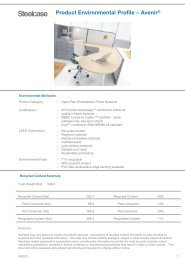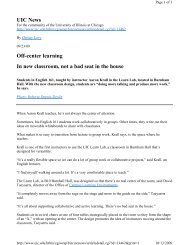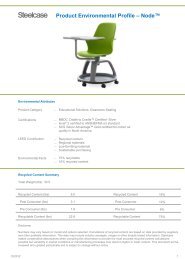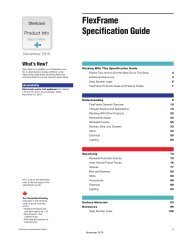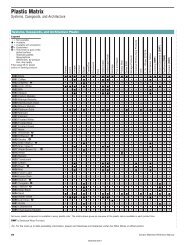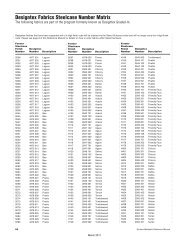Post 80s: China - Steelcase
Post 80s: China - Steelcase
Post 80s: China - Steelcase
Create successful ePaper yourself
Turn your PDF publications into a flip-book with our unique Google optimized e-Paper software.
<strong>Post</strong>-80’s: <strong>China</strong><br />
©2011 <strong>Steelcase</strong> Inc.<br />
WorkSpace Futures
workspace futures<br />
Table of Contents<br />
Introduction..................................................................................... 2<br />
Our Process.................................................................................... 4<br />
Phase 1: Understand...................................................................... 6<br />
Phase 1: Understand — Key Findings.......................................... 13<br />
Phase 2: Observe.......................................................................... 14<br />
Phase 2: Observe — Key Findings............................................... 19<br />
Phase 3: Synthesize...................................................................... 20<br />
Key Shifts...................................................................................... 21<br />
Design Principles.......................................................................... 27<br />
Special Concepts.......................................................................... 28<br />
In Closing...................................................................................... 36<br />
The Team....................................................................................... 37<br />
Notes/Bibliography....................................................................... 38<br />
360.steelcase.com GenY °<br />
1
introduction<br />
Introduction<br />
2<br />
360.steelcase.com GenY °
introduction<br />
Why study <strong>China</strong>?<br />
<strong>Steelcase</strong>’s WorkSpace Futures conducted a study of Gen Y in<br />
the US, in an effort to understand its impact on the workplace.<br />
Upon completion of that research, we began to wonder whether<br />
the insights we had uncovered here would also apply around<br />
the world. <strong>China</strong> and India immediately became likely candidates<br />
for further research, due to the sizes of their respective Gen Y<br />
populations.<br />
<strong>China</strong> & India have a combined population of 2.5 billion = 1/3<br />
of the global population<br />
In the US, Gen Y represents 70 million people between the<br />
ages of 10 and 30. India’s Gen Y population is 426 million of the<br />
same age; <strong>China</strong>’s equivalent population is 218 million, ranging<br />
from age 20 to 30. In addition, <strong>China</strong> and India have emerged<br />
as the second and fourth largest economies, respectively, in the<br />
world, representing an enormous opportunity for <strong>Steelcase</strong> and<br />
our customers.<br />
The graph below shows the Gen Y population for each country<br />
measured against the total population of that country.<br />
We learned from our US research that generations are defined<br />
by the key memories their members share, so we assumed that<br />
the Chinese and Indian Gen Y populations would exhibit different<br />
characteristics than their US counterparts, but we didn’t know<br />
what those characteristics would be.<br />
What role would culture play in determining this generation’s<br />
values? What roles would politics and the economy play?<br />
What about technology? How would these areas influence this<br />
generation’s feelings about work and workplace – and what might<br />
that workplace look like in 20 years?<br />
<strong>Steelcase</strong> WorkSpace Futures conducted a six month study<br />
of the Generation Y demographic in <strong>China</strong> starting in October<br />
of 2009. This group is referred to as <strong>Post</strong>-80’s within <strong>China</strong>,<br />
representing individuals born between 1980-1990. In establishing<br />
our research in <strong>China</strong>, we employed as much as possible the<br />
same methodologies used in the US study. We discovered,<br />
however, that certain research approaches weren’t possible due<br />
to culturally-accepted norms of behavior. For example, due to the<br />
inherent inhibitions against standing out in front of a crowd, we<br />
found it nearly impossible to conduct group workshops, and had<br />
to rely almost entirely on personal interviews. In addition, we were<br />
not allowed to take photographs inside any of the companies.<br />
Our interview subjects represented a select population, being<br />
urban, educated, and employed primarily at multinational<br />
corporations. Although we attempted to gain access to numerous<br />
Chinese companies, in addition to multinationals, we ultimately<br />
found only one Chinese company willing to invite us in and grant<br />
access to its employees. We believe this was due primarily to<br />
the lack of exposure to this type of research, a situation which<br />
we hope to resolve through a strategic roll-out of the findings<br />
throughout greater <strong>China</strong>. We believe the findings contained in<br />
this book will be beneficial to our Chinese colleagues as well as<br />
those in the US.<br />
WorkSpace Futures Explorations<br />
June 2010<br />
360.steelcase.com GenY °<br />
3
introduction<br />
Research Methods<br />
Our process<br />
Our Research Process<br />
At WorkSpace Futures, we follow a rigorous six-stage, human-centered design research<br />
process. We borrow heavily from techniques in ethnography and cultural anthropology.<br />
Through the research process, we have built a rich qualitative description of <strong>Post</strong>-80’s<br />
in order to provide a meaningful context for our key research questions.<br />
4<br />
360.steelcase.com GenY °
introduction<br />
UNDERSTAND<br />
Learning from subject experts regarding trends, business<br />
impacts and new techniques and technologies.<br />
OBSERVE<br />
Collecting information firsthand through asking open ended<br />
questions, observing people and processes, and engaging<br />
participants in co-creation activities to uncover new patterns<br />
of behaviors.<br />
SYNTHESIZE<br />
Recognizing patterns and anomalies from both secondary<br />
research and observation, allowing us to develop insights<br />
and new concepts.<br />
REALIZE<br />
Ideating solutions, through sketches, floor plans and strategies.<br />
This becomes the mode of communication for sharing our<br />
research findings.<br />
PROTOTYPE<br />
Converting solutions into prototypes enables us to elicit feedback<br />
from real users as we develop concepts from the Realize phase.<br />
This allows us to document evidence of progress and refine<br />
solution prototypes for higher chances of success.<br />
(Gen Y in Asia has not yet reached this stage of exploration.)<br />
MEASURE<br />
Developing meaningful measures for testing prototypes allows us<br />
to validate our solutions against identified user needs, for product<br />
design as well as space applications. Measurement activities<br />
can include pre- and post-occupancy surveys, time-lapse video<br />
observation, simulation exercises with users, and IRB-approved<br />
experiments with users.<br />
(Gen Y in Asia has not yet reached this stage of exploration.)<br />
360.steelcase.com GenY °<br />
5
understand<br />
Understand<br />
6<br />
360.steelcase.com GenY °
understand<br />
The big picture<br />
Understanding: Four categories<br />
The following pages are intended to provide<br />
a more detailed backdrop about <strong>Post</strong>-80’s<br />
in <strong>China</strong> through the filters of Culture, Politics,<br />
Economics, and Technology.<br />
Culture<br />
<strong>China</strong>’s culture is a rich and complicated blend of ancient<br />
traditional customs, 20th century Communist political<br />
structure and modern international influences. Traditional<br />
Chinese culture is represented by the Han majority, which makes<br />
up approximately 92% of the population of <strong>China</strong>. There are,<br />
however, 55 minority groups within <strong>China</strong>, with varying histories<br />
of interaction and/or inclusion in the majority culture. 1<br />
While customs may vary from group to group, the basis for the<br />
majority Chinese culture is based on Confucian, Taoist and<br />
Buddhist philosophies, mixed with local beliefs. According to<br />
Confucian teachings, society is based on adherence to five key<br />
relationships, or bonds: ruler-subject, father-son, husband-wife,<br />
elder brother-younger brother, and elder friend-younger friend.<br />
Inherent in these relationships is the notion of strict expectations<br />
of attitude for each role. Confucius believed that lawlessness<br />
in society was caused by people trying to conform to laws<br />
without understanding their rationale. Instead, he taught that by<br />
internalizing expected behaviors, people would be governed by<br />
their desire to avoid shame and embarrassment. Society would<br />
then function smoothly without the need for coercion. 2<br />
Chinese culture developed in relative isolation, surrounded<br />
by smaller, tributary populations whose societies shared the<br />
same Confucian/Taoist/Buddhist ethos. Despite the fact that<br />
Europeans began visiting <strong>China</strong> in the 1500s for trading purposes,<br />
it remained largely immune to Western influences until the early<br />
1800s, due to the imperial government’s policy of restricting<br />
European traders to specific port cities. 3<br />
divisions between rural and urban populations, and hierarchy of<br />
managers over producers to impose control over the populace.<br />
This changed with the Cultural Revolution, which outlawed<br />
the practice of religion in any form, and denigrated traditional<br />
Confucian morality, replacing both with a cult of personality<br />
around Mao Zedong. The Cultural Revolution came to an end with<br />
Mao’s death in 1976; traditional Chinese culture was eventually<br />
revived and is now flourishing. 4<br />
The traditional reliance on “guanxi,” or relationships, still governs<br />
much of the business practices in <strong>China</strong>, in addition to personal<br />
relationships. More than simply describing relationships, ”guanxi”<br />
expresses the obligations inherent in these relationships; most<br />
Chinese have a network of contacts upon which they can call<br />
when they need something to be done or through which they can<br />
exert influence on behalf of others. 5<br />
Since the economic reforms of 1978, Chinese society has<br />
been increasingly exposed to outside cultural influences,<br />
particularly those of the West. Modern Chinese are watching<br />
popular television dramas from South Korea, listening to various<br />
pop artists from Taiwan and Hong Kong, watching American<br />
movies, and reading Japanese fashion magazines. The younger<br />
generations are hanging out at nightclubs and bars late into<br />
the night. There is a growing enthusiasm for high-end branded<br />
products, slang is starting to incorporate more and more English<br />
words, and the tech savvy Chinese flock to get the latest models<br />
of cell phones, computers, and Apple products. 6<br />
After the establishment of the People’s Republic of <strong>China</strong> in 1949,<br />
traditional Chinese culture was tolerated, and even leveraged, as<br />
the Communist government used existing notions of authority,<br />
360.steelcase.com GenY °<br />
7
understand<br />
Politics<br />
Sixty years ago, following a Civil War with the Kuomintang,<br />
Mao Zedong’s Communist forces emerged victorious and<br />
declared the People’s Republic of <strong>China</strong> on October 1,<br />
1949. Mao set about overhauling the land ownership system<br />
and setting up a Soviet-style centrally controlled economy. In a<br />
bid to transform <strong>China</strong> from an agrarian economy to a modern<br />
industrialized communist state, Mao implemented the Great Leap<br />
Forward which was then followed by the Cultural Revolution. 7<br />
These two social programs turned society upside down and<br />
nearly brought <strong>China</strong> to the brink of collapse. By the time Mao<br />
died in 1976, <strong>China</strong> was a poor totalitarian government with<br />
very few outside ties to the world. Deng Xiaoping succeeded,<br />
and in 1978 he brought about massive economic reforms by<br />
shedding central planning, opening up to the world, and creating<br />
a market economy. Since that time, <strong>China</strong> has revived itself as an<br />
economic powerhouse and formidable player on the world stage. 8<br />
The People’s Republic of <strong>China</strong> celebrated its 60th birthday<br />
in 2009. The celebration on October 1st was marked by an<br />
impressive array of festivities, chief among them being the<br />
biggest military review ever showcased by <strong>China</strong>. The elaborate<br />
ceremony was a precisely-choreographed event shown on<br />
national television and viewed by the world. The procession<br />
included a stream of floats accompanied by more than 100,000<br />
people, a dozen fighter jets, hundreds of tanks, artillery, and<br />
trucks carrying long-range nuclear missiles. The parade was<br />
visible evidence to the world of <strong>China</strong>’s expanding global might<br />
and its emergence into the international arena. 9<br />
Displays like those surrounding <strong>China</strong>’s 60th Anniversary are part<br />
of what has made the <strong>Post</strong> 80’s crowd an optimistic group who<br />
are patriotic and loyal to their country. The <strong>Post</strong> 80’s generation<br />
of <strong>China</strong> has grown up under a relatively politically stable and<br />
economically prosperous time. Educated young Chinese are<br />
the biggest beneficiaries of the market reforms implemented in<br />
the 1970’s by Deng. The reforms have resulted in the economy<br />
growing at double digit rates for as long as they can remember<br />
and have brought <strong>China</strong> more peace and prosperity than at any<br />
time in the past thousand years. 10<br />
Economics<br />
Since Deng Xiaoping introduced market reforms in 1978,<br />
<strong>China</strong> has transformed itself from a centrally planned<br />
economy closed to foreign trade to a market economy<br />
that is not only open to foreign trade, but has become a<br />
major player in international markets. 11 The country recently<br />
surpassed Germany as the largest exporter in the world, and<br />
is predicted to become the largest economy by the end of the<br />
century. 12 Despite fears for Hong Kong’s economy after its return<br />
to <strong>China</strong> in 1997, the island has remained one of the world’s<br />
largest trading centers, and continues to be ranked as the world’s<br />
freest economy. 13 In addition, the port of Hong Kong is rated as<br />
one of the top three busiest in the world for container traffic. 14<br />
With the rise of <strong>China</strong>’s economy, room for personal choice<br />
has expanded, particularly for <strong>Post</strong>-70’s and <strong>Post</strong>-80’s.<br />
In just 30 years of market reforms, the Chinese people have<br />
experienced a major upgrade of their living standards. Four<br />
hundred million people have been lifted out of poverty since<br />
1979. With decentralization and lifting of the travel ban, millions<br />
of rural residents have migrated to the cities, expanding the<br />
urban population to 46% in 2009. 15 Reforms have also resulted<br />
in more opportunities for higher education at home and abroad.<br />
With wages going up, the Chinese are taking advantage of their<br />
new buying power. Ten million people now own private cars;<br />
the country had 747 million mobile phone subscribers in 2009. 16<br />
An endless variety of choices in food, clothing, and other<br />
consumer goods means Chinese consumers have a strong<br />
sense of optimism about their country’s economy, even after<br />
the recession of 2008. 17<br />
The original attraction to <strong>China</strong> for foreign companies was<br />
cheap manufacturing labor, but today there is growing emphasis<br />
on the technology sector, IT, R&D, and service industries,<br />
allowing employers to take advantage of highly-educated<br />
graduates. In 2009, however, <strong>China</strong> saw the beginning of a<br />
job shortage among new graduates, which has begun to put<br />
enormous strain on the youngest members of the <strong>Post</strong>-80’s<br />
generation. 18 The optimism for which this generation is so<br />
famous may be facing its first challenge.<br />
8<br />
360.steelcase.com GenY °
understand<br />
Technology<br />
The rapid economic development in <strong>China</strong> is basis<br />
for the continuous growth in the size of the internet<br />
user population. The increased investment in infrastructure<br />
facilities, the encouragement of household appliances in the<br />
countryside policy, and the launch of the 3G network have<br />
prompted this growth of internet users in <strong>China</strong>. As of December<br />
2009, there were 384 million users – more than the entire<br />
population of the US! Much of the increased internet activity is<br />
happening in the home (83.2% of users on the Mainland, 96%<br />
in Hong Kong), but use of the internet at work is also increasing,<br />
as users take advantage of the ability to access information<br />
previously unavailable. 19<br />
While the West was watching Google’s battle with the Chinese<br />
government in 2009, Chinese consumers were going about<br />
their business undisturbed. The Chinese internet firm Baidu<br />
already dominated the Chinese search engine market, and other<br />
companies such as Tencent and Sohu were ready to take over<br />
the 25% market share owned forfeited by Google. As of the third<br />
quarter of 2010, Baidu owned almost 73% of the market share,<br />
while Google had dropped to just under 25%. 23<br />
These numbers hide the real story, however: the rise of mobile<br />
internet use. With the deep penetration of 3G networks by all<br />
major telecom operators, the number of Chinese mobile users<br />
accounts for 60.8% of all internet users. These 233 million users<br />
are accessing the internet for online financial transactions, such<br />
as bill payments, listening to music, playing games, or shopping.<br />
Of this group, rural users account for 27.8% of mobile internet<br />
access, thanks to the availability of G3. 20<br />
Apple products are becoming increasingly popular, and the<br />
brand is viewed as an aspirational one, similar to BMW. A Morgan<br />
Stanley survey in 2009 found that more high-income consumers<br />
in <strong>China</strong> intend to purchase an iPhone than their counterparts in<br />
the US. 21 Mobile use isn’t the only area in which <strong>China</strong>’s numbers<br />
dwarf those in the US. <strong>China</strong> has many more developers of<br />
online games and services than the US. Seventy million Chinese<br />
consumers play at least an hour of online games a month. Unlike<br />
most western gaming firms, Chinese firms offer a la carte options,<br />
which opens up the market to purchasers with smaller incomes.<br />
And they’re not just playing games, they’re also buying $5 billion<br />
worth of virtual goods, five times the volume in the U.S. 22<br />
360.steelcase.com GenY °<br />
9
understand<br />
Generations<br />
Traditionals:<br />
1928-45<br />
Lost Generation:<br />
1946-64<br />
<strong>Post</strong>-70’s:<br />
1965-79<br />
<strong>Post</strong>-80’s:<br />
1980-90<br />
Who are the Generations in <strong>China</strong>?<br />
Modern generations in <strong>China</strong> are usually defined by decades.<br />
For example, the US equivalent of Gen Y is referred as the<br />
<strong>Post</strong>-80’s generation in <strong>China</strong>. Nicknamed the “Little Emperors,”<br />
The <strong>Post</strong>-80’s child has often been indulged as the only child<br />
in families with two parents and four grandparents.<br />
During our research, the majority of individuals interviewed<br />
were from <strong>Post</strong>-80’s and <strong>Post</strong>-70’s generations. Due to the early<br />
retirement age in <strong>China</strong>, as well as educational constraints on<br />
workers from previous decades, there are currently far fewer<br />
older workers in the workplace than in the US.<br />
Gen Xers in <strong>China</strong> are referred to as the <strong>Post</strong>-70’s generation.<br />
Growing up during the post-Mao Era, this generation grew<br />
up during the period of Economic Reforms and Openness.<br />
The <strong>Post</strong>-70’s generation was also the first generation to come<br />
of age in a consumer society and enjoy more personal rights<br />
and freedoms than the previous generations in <strong>China</strong>.<br />
Baby Boomers are known as the Lost Generation in <strong>China</strong> due<br />
to the political policies in place while they were growing up. The<br />
1960s and 1970s were the years during the Cultural Revolution.<br />
Under Mao’s socialist orthodoxy, both traditional Chinese and<br />
Western culture were repressed, social institutions collapsed,<br />
schools were abolished, public transportation came to a nearly<br />
complete halt, temples and churches were vandalized, and<br />
“liberal bourgeoisie” and intellectuals purged. This generation<br />
grew up with the belief that loyalty to the state and institutions<br />
would be rewarded, questioning authority was unacceptable,<br />
education was unnecessary, and anything “foreign” or “old<br />
fashioned” was unwanted. After the death of Mao, the Cult of Mao<br />
quickly collapsed, leaving many in this generation disillusioned<br />
and ill-prepared to participate in the modern world.<br />
The generation before the Lost Generation is known as the<br />
Traditionals. This generation grew up during a tumultuous time<br />
when the second Sino-Japanese War ended and civil war raged<br />
between the Kuomintang and the Communist parties. In 1949, the<br />
Nationalists lost the war, fleeing to Taiwan, and the Communist<br />
party took power, establishing the People’s Republic of <strong>China</strong>.<br />
Mao then initiated major economic reforms in a big push to<br />
industrialize <strong>China</strong>.” It was a time of conflict and confusion as<br />
traditional ways of life were uprooted in pursuit of modernization.<br />
This generation learned that affiliating with the “right” people<br />
was essential for survival, advice they undoubtedly offered to<br />
their children.” 24<br />
10<br />
360.steelcase.com GenY °
understand<br />
Generations: Memories Shared<br />
To better understand the dynamics of how generations develop characteristics –<br />
specifically the evolution of <strong>Post</strong>-80’s characteristics – we conducted a unique<br />
timeline activity. We brought together people whose ages spanned three-generations.<br />
We asked the participants to write down ten events that happened during their<br />
lifetimes, that impacted society. Note: The colors indicate which generations wrote<br />
down a particular event. The age ranges of the individuals who participated in this<br />
exercise are listed below.<br />
360.steelcase.com GenY °<br />
11
understand<br />
Key Characteristics<br />
Key characteristics of<br />
the post-80’s generation<br />
a Eager to learn<br />
a Confident<br />
a Like to communicate<br />
a Open-minded<br />
a Energetic<br />
a Tech-savvy<br />
a Looking for forward progress<br />
a Trendy<br />
a Self-centered<br />
a Active<br />
a Optimistic<br />
a Willing to take risks<br />
a Can’t endure hardship<br />
a Dependent on parents<br />
a Creative<br />
a Educated<br />
a More active virtually than face-to-face<br />
12<br />
360.steelcase.com GenY °
understand<br />
Key Findings<br />
Characteristics & Resulting Behaviors.<br />
Like to communicate, Energetic, Active, More active<br />
virtually than Face-to-face, Tech-savvy<br />
Want to be asked for their opinion<br />
Want to be active participants in the process,<br />
not just come to work to perform a task<br />
Open-minded, Looking for forward progress, Self-centered,<br />
Creative, Educated, Forward-thinking<br />
Always looking to grow through “Exploration”<br />
(travel, TV, talking to others, classes, Internet)<br />
Looking forward to the future<br />
Comfortable communicating via phone, email, IM<br />
Working long-distance with global colleagues is no problem<br />
Compared to previous generations,<br />
this one is considered selfish<br />
Still retain many traditional Chinese values towards family,<br />
but it’s mixed now with the desire to fulfill one’s own dreams<br />
Eager to learn, Confident, Trendy, Optimistic, Willing to take<br />
risks, Can’t endure hardship, Dependent on parents<br />
Confident they can do anything they are asked to do<br />
Often need mentoring, but aren’t afraid to try something<br />
new on their own if the culture supports it<br />
Follow latest trends and brands, so will gravitate towards<br />
“cool” companies<br />
Any opportunity is a learning opportunity<br />
360.steelcase.com GenY °<br />
13
observe<br />
Observe<br />
14<br />
360.steelcase.com GenY °
observe<br />
Beijing<br />
Consulting<br />
Chemical R&D<br />
Fuzhou<br />
Xiamen<br />
Guangzhou<br />
Hong Kong<br />
Macao<br />
Shanghai<br />
Wenzhou<br />
Technology<br />
Pharmaceutical<br />
Creative<br />
Manufacturing<br />
Services<br />
Sites Visited<br />
In conducting our three-pronged observation research, the WSF<br />
team travelled to four cities across <strong>China</strong>, as shown below.<br />
The companies studied were all Multi-National Companies (MNC)<br />
with the exception of one Chinese-owned company.<br />
Company type<br />
# Participants<br />
...........................................................................................................<br />
Consulting 11<br />
Chemical A&D 4<br />
Technology 8<br />
Pharmaceutica 6<br />
Creative 30<br />
Manufacturing 14<br />
Services 7<br />
...........................................................................................................<br />
TOTAL 80<br />
What We Heard<br />
Workplace Values: <strong>China</strong><br />
a Good reputation<br />
a Friendly environment<br />
a Relaxed environment<br />
a Personal office<br />
a Personalization<br />
a Happiness<br />
a Culture of equality & support<br />
a Work-life balance<br />
a Learning<br />
a Social events at work<br />
In establishing our research in <strong>China</strong>, we employed as much<br />
as possible the same methodologies used in the US study. As<br />
mentioned earlier, however, we discovered that certain research<br />
approaches weren’t possible due to culturally-accepted norms<br />
of behavior. For example, due to the inherent inhibitions against<br />
standing out in front of a crowd, we found it nearly impossible<br />
to conduct group workshops, and had to rely almost entirely<br />
on personal interviews. In addition, we were not allowed to take<br />
photographs inside any of the companies. Because of the latter<br />
restriction, the Observe section of this document will be less<br />
about what we saw and more about what we heard.<br />
360.steelcase.com GenY °<br />
15
observe<br />
What we heard<br />
About Workspace<br />
About Communication<br />
“Not enough space, can’t organize<br />
things the way I want... it’s inconvenient,<br />
not efficient, I waste a lot of time looking<br />
for things.”<br />
“My team sits close together... easy to<br />
communicate, but there’s no privacy.”<br />
“We spend a lot of time communicating<br />
with people, more focused on relationships<br />
instead of just working hard like our parents.”<br />
“I couldn’t live without my mobile... it lets<br />
me communicate with my friends.”<br />
About Recognition & Reward<br />
About Learning<br />
“I want to be rewarded by being<br />
given additional opportunities.”<br />
“Give me room to grow...<br />
reward my hard work.”<br />
“I want to work somewhere<br />
where I can hone my skills.”<br />
“My best experience at work was when<br />
I got to learn about tax regulations –<br />
I added to my career knowledge.”<br />
“My laptop provides information<br />
I can’t get anywhere else.”<br />
About Office Culture<br />
About Work-Life Balance<br />
“Make the internal network<br />
more transparent.”<br />
“If I notice something I can improve,<br />
I’ll tell my manager.”<br />
“I have less time for my personal life.”<br />
“I need to work to have a good life, and can’t<br />
work well without a good life – they depend<br />
on each other.”<br />
“The whole team goes out for dinner…<br />
we talk and play games.”<br />
16<br />
360.steelcase.com GenY °
observe<br />
Engage<br />
Participatory design — Collage making:<br />
Participatory design activities are used to gain deeper insights<br />
from participants and engage them at both intellectual and<br />
emotional levels.<br />
Traditionally, when we ask questions, participants tend to<br />
respond intellectually – thinking it through with a response that<br />
provides explicit information. Observing participants’ behaviors<br />
and interactions leads to discoveries at a deeper level, which<br />
helps to understand unspoken, unarticulated and implicit needs.<br />
In participatory design activities, another level of information is<br />
revealed as participants create or make things. The social nature<br />
of this particular aspect of our research allows an individual’s<br />
personality, as well as deep feelings, to be reflected in the work<br />
he or she creates.<br />
The tool used was called Expression, proprietary software<br />
designed and created by WorkSpace Futures. The tool is intuitive<br />
and easy to use with a photo and word gallery from which<br />
subjects choose key words and images.<br />
For this research, we employed an activity called collaging.<br />
We asked each participant to create two collages describing:<br />
1. Their current work environment<br />
2. Their ideal work environment, by choosing photos<br />
and words from the galleries.<br />
There were no restrictions on the number of photos or words that<br />
they could choose. They could also move, resize and group the<br />
chosen photos and words as they desired. After the collages were<br />
created, participants were asked to explain the thinking behind<br />
their choices.<br />
Current Work Environment<br />
“Piled paper = lots of work, work is routine, can’t live without<br />
computer at work, so many emails. Worked here 1.5 yrs, already<br />
on my 3rd manager. Many changes, trying new things is fun for<br />
me. So many people on my global marketing team, so many<br />
emails. We work in cubicles. Career path.”<br />
Ideal Work Environment<br />
“Work-life balance, not such routine work. Linked more directly<br />
to customers, more leisure, more informal areas. More sharing<br />
with colleagues, more fun. Motivation, other than monetary,<br />
i.e. holidays, team building events. Change. Computer is the<br />
foundation of work process. Growth in terms of business &<br />
personal development.”<br />
360.steelcase.com GenY °<br />
17
observe<br />
Engage<br />
When we compared collages created by <strong>Post</strong>-80’s and<br />
<strong>Post</strong>-70’s, we noticed a few differences. While <strong>Post</strong>-80’s<br />
were more universal in their choices for Current and Ideal<br />
environments, <strong>Post</strong>-70’s didn’t share one common image in<br />
describing the Current work environment, and only one common<br />
image for the Ideal. Differences could be the result of images<br />
being chosen by Western researchers, therefore losing some<br />
context for Chinese participants. <strong>Post</strong>-80’s, with more exposure<br />
and understanding of Western trends, may also be better able<br />
to understand the meaning of images. <strong>Post</strong>-70’s, on the other<br />
hand, may have a more difficult time ascribing the intended<br />
meaning to the images, leading to so many individual choices.<br />
<strong>Post</strong>-80’s : Current<br />
<strong>Post</strong>-80’s : Ideal<br />
Top Word Choices : Routine, Freedom, Fun<br />
Top Word Choices : Fun, Shared<br />
Top Image Choices :<br />
Top Image Choices :<br />
<strong>Post</strong>-70’s : Current<br />
<strong>Post</strong>-70’s : Ideal<br />
Top Word Choice : Professional, Teams<br />
Top Image Choices :<br />
Top Word Choices : Creativity, Flexible,<br />
Inspiring, Teams<br />
Top Image Choices :<br />
18<br />
360.steelcase.com GenY °
observe<br />
Key Findings<br />
What We Learned<br />
Work<br />
• Overtime is expected, though not welcomed<br />
• Individuals work to contribute to the greater goal<br />
• Teams are department-based, not project-based<br />
• Innovation is beginning to be part of the expectation<br />
• New opportunities are considered equally important<br />
as promotion<br />
• Anything new is an opportunity – travel, training, new projects<br />
Work-Life<br />
• They are more focused on individual needs<br />
• Socialization with friends is often more important<br />
than with family<br />
• They desire clear boundaries between work & life<br />
• They want work hours to be set so they know when<br />
they can expect to go home<br />
• They feel guilt for not spending enough time with parents<br />
Worker<br />
• Individuals value feeling a sense of accomplishment<br />
• Employees want to know how they are contributing<br />
to the greater picture<br />
• There’s a new sense of competitiveness<br />
• They’re more globally aware<br />
• They’re socially-networked<br />
• They feel responsible for the company’s image & success<br />
Work Environment<br />
• Pantry spaces are essential informal gathering places<br />
• They desire to have a variety of spaces for work & relaxation<br />
• They want adequate space for each person<br />
• Individual privacy is hard to find<br />
• Location is important — commuting time is a factor<br />
• Storage tends to be digital, but need some paper files,<br />
and space for worktools<br />
• Relationships are an important part of work and life<br />
• Growth is most important goal at work<br />
• Learning happens everywhere – work is no exception<br />
360.steelcase.com GenY °<br />
19
Synthesize<br />
Synthesize<br />
20<br />
360.steelcase.com GenY °
Synthesize<br />
Key Shifts<br />
1 2 3 4 5 6<br />
Harmony<br />
Identity<br />
Harmony was and is the basis of social behavior in <strong>China</strong>. This isn’t conformity. Rather, individuals have<br />
learned to adjust their identities to blend with the society around them – as members of a group, rather<br />
than as individuals. Now, young people are starting to create their own identities based purely on their<br />
own interests. This can be partially attributed to this being a generation of single children. Though this<br />
can create conflict with traditional values – seeing this new behavior as selfish – <strong>Post</strong>-80’s still maintain<br />
strong values of familial responsibility, creating a new blend of modern and traditional.<br />
Harmony<br />
• Harmony is goal of society<br />
• Individuals learn to blend themselves into<br />
the whole, rather than trying to stand out<br />
Identity<br />
• Desire for increasing individuality<br />
• Growing interest in following one’s own desires<br />
• Desire to fulfill society’s expectations<br />
360.steelcase.com GenY °<br />
21
Synthesize<br />
Key Shifts<br />
1 2 3 4 5 6<br />
Teamwork<br />
Collaboration<br />
The second shift is from Teamwork to Collaboration and this is very closely tied with the previous shift.<br />
In the US, we talk about office work moving from I to We. Collaboration depends on the willingness and<br />
ability of individuals to express their ideas and opinions, and to debate options before reaching a shared<br />
point of view. In <strong>China</strong>, society is moving from We to I, as individuals begin to express their own identities.<br />
Collaboration will become easier, as people become more comfortable with expressing differing<br />
opinions and working constructively through conflict.<br />
teamwork<br />
• Teams are department-based,<br />
not project-based<br />
• Focused on completing the assigned task<br />
as a group<br />
• Hierarchy rules – leader dictates assignment<br />
and process<br />
collaboration<br />
• Teams are project-based<br />
• Focused on pooling ideas to generate<br />
new ideas as a group<br />
• Team is encouraged to contribute<br />
22<br />
360.steelcase.com GenY °
Synthesize<br />
Key Shifts<br />
1 2 3 4 5 6<br />
Job Security<br />
Growth<br />
In the past, job security was highly-desired and having a job for life was often more important than what<br />
that job was. People were dependent on pensions from their companies or the government, for support<br />
after retirement, or they took another job to continue to earn income. Now, continuous learning is<br />
more important than job security. Young people expect to be independent, to be able to take care of<br />
themselves and their families after retirement. This new generation is also becoming more entrepreneurial<br />
due to increased competition for limited jobs and the global economic crisis.<br />
Job Security<br />
• Assurance of steady income is most<br />
important thing<br />
• Dependent on others for after<br />
retirement support<br />
• Willing to trade potential opportunities<br />
for job security<br />
Growth<br />
• Continuous learning and fair compensation<br />
are more important than security<br />
• Becoming independent and taking care<br />
of self and family<br />
• Expect employers to provide opportunities<br />
and guidance<br />
• Not afraid to leave a job and pursue<br />
better opportunities<br />
360.steelcase.com GenY °<br />
23
Synthesize<br />
Key Shifts<br />
1 2 3 4 5 6<br />
Supporting<br />
the Work<br />
Supporting<br />
the Worker<br />
The fourth shift from Supporting the Work to Supporting the Worker means thinking about the person<br />
instead of the task. Companies used to think only about employees when they were at work doing their<br />
jobs. Now, employees expect to get more out of the work experience. They want to be able to socialize<br />
with colleagues and to be able to do overtime at home. The new generation is looking for a variety of<br />
spaces to be provided – for different kinds of work as well as informal breaks.<br />
Supporting the Work<br />
• People come to work to do the work only<br />
• Employer provides workspace and tools<br />
• Overtime has to be performed at work<br />
Supporting the Worker<br />
• People expect opportunities to socialize at work<br />
(meals are a social occasion in Chinese culture)<br />
• Employer provides a variety of spaces<br />
for work and relaxation<br />
• Overtime may be performed at home<br />
24<br />
360.steelcase.com GenY °
Synthesize<br />
Key Shifts<br />
1 2 3 4 5 6<br />
Worker<br />
Explorer<br />
This generation is all about learning and exploring. Instead of applying for whatever job may be available,<br />
they are applying to companies that seem to offer the most opportunities for growth. They want to<br />
develop their own career path, and aren’t afraid to change jobs to do it. Instead of just performing the<br />
tasks assigned, they want to help their companies be better – and perform better – by going beyond<br />
what is expected.<br />
worker<br />
• People apply for job being offered<br />
• Individuals follow a traditional career<br />
path, or one predetermined for them<br />
• Employees help the company be profitable<br />
by doing the expected work<br />
explorer<br />
• People apply where they see opportunities<br />
to explore<br />
• Individuals want to develop their own<br />
career path (with career guidance)<br />
• Employees help the company compete<br />
by looking for better ways of doing things<br />
360.steelcase.com GenY °<br />
25
Synthesize<br />
Key Shifts<br />
1 2 3 4 5 6<br />
Work &<br />
Life<br />
Working &<br />
Living<br />
Work used to be about going to an office and performing your assigned tasks and Life was about going<br />
home to be with family. The two were kept quite separate and work took priority. Expectations for<br />
some greater work-life balance were low because exposure to other alternative, was low. Today, work<br />
represents so much more. “Working” implies an active role in the company, contributing to new ideas,<br />
new processes, and new ways of working. “Living” means a more active, broader scope to life –<br />
it reaches beyond family to include friends, traveling, and hobbies. Living means learning.<br />
Work & Life<br />
• Work is only about work at workplace,<br />
and Life is only about family outside the work<br />
• Work comes first<br />
• Limited awareness means lower expectations<br />
Working & Living<br />
• Work is more than just work, and Life<br />
is more than family<br />
• Work and Life equally important<br />
• Global awareness means higher expectations<br />
• Work hard, play hard<br />
Previous Generations<br />
a Harmony<br />
a Teamwork<br />
a Job Security<br />
a Supporting the Work<br />
a Worker<br />
a Work & Life<br />
<strong>Post</strong>-80’s<br />
a Identity<br />
a Collaboration<br />
a Growth<br />
a Supporting the Worker<br />
a Explorer<br />
a Working & Living<br />
26<br />
360.steelcase.com GenY °
Synthesize<br />
Design Principles:<br />
The following design principles are intended to help designers<br />
think about new ways to design work spaces in <strong>China</strong>, in order<br />
to leverage the skills brought by the <strong>Post</strong>-80’s generation.<br />
Instead of viewing this as a rule book telling them how to design,<br />
we encourage our clients to use this as a checklist, to remind<br />
them of key elements necessary to bring out the best of the<br />
<strong>Post</strong>-80’s.<br />
1<br />
Design for Identity<br />
• It’s about encouraging employees<br />
to express their identity<br />
2<br />
Design for Collaboration<br />
• It’s about allowing teams to be together<br />
while maintaining individual privacy<br />
• It’s about providing various<br />
team settings<br />
• It’s about fostering social interaction<br />
as a team<br />
• It’s about encouraging and allowing<br />
people to share their points of view<br />
3<br />
Design for Growth<br />
• It’s about providing environments<br />
for learning<br />
• It’s about actively helping employees<br />
in their development<br />
• It’s about being transparent<br />
4<br />
Design for the Worker<br />
• It’s about taking care of the whole<br />
person: mind, body, and spirit<br />
• It’s about supporting work<br />
in and outside the office<br />
5<br />
Design for the Explorer<br />
• It’s about encouraging and training<br />
for thinking outside the box<br />
• It’s about enabling access<br />
to information<br />
• It’s about offering opportunities<br />
6<br />
Design for Working & Living<br />
• It’s about supporting life beyond work<br />
• It’s about adding fun to work and<br />
work-life<br />
He that would perfect his work must first sharpen his tools.<br />
– Confucius<br />
360.steelcase.com GenY °<br />
27
ealize<br />
Spatial Concepts<br />
In the final phase of Realize, we conducted a design charette with<br />
individuals representing the product marketing, design, research<br />
and human resources departments.<br />
Over a two-day work session, the team generated ideas –<br />
sketches, strategies and policies – around the Key Shifts and<br />
Design Principles identified in our research. These ideas served<br />
as a provocative point of departure for new thinking on the next<br />
phase of work-life environments, tools and behaviors.<br />
1<br />
Design for Identity<br />
• Encourage employees to express their identity<br />
28<br />
360.steelcase.com GenY °
ealize<br />
2<br />
Design for Collaboration<br />
• Foster social interaction as a team<br />
• Provide various team settings<br />
• Encourage & allow people to share<br />
their points of view<br />
• Allow teams to be together while<br />
maintaining individual privacy<br />
360.steelcase.com GenY °<br />
29
ealize<br />
3<br />
Design for Growth<br />
• Provide environments for learning<br />
• Help employees in their development<br />
• Be transparent<br />
30<br />
360.steelcase.com GenY °
ealize<br />
4<br />
Design for the Worker<br />
• Support work inside and outside the office<br />
• Take care of mind, body, and spirit<br />
360.steelcase.com GenY °<br />
31
ealize<br />
5<br />
Design for the Explorer<br />
• Enable access to information<br />
• Encourage thinking outside the box<br />
• Offer new opportunities<br />
32<br />
360.steelcase.com GenY °
ealize<br />
360.steelcase.com GenY °<br />
33
ealize<br />
6<br />
Design for Working & Living<br />
• Support life beyond work<br />
• Add fun to work and work-life<br />
34<br />
360.steelcase.com GenY °
ealize<br />
360.steelcase.com GenY °<br />
35
in closing<br />
In Closing<br />
What We Learned<br />
What are you doing differently to attract and retain<br />
the best talent?<br />
Are you adopting the technologies that <strong>Post</strong>-80’s<br />
live with – and expect to use?<br />
Are you leveraging <strong>Post</strong>-80’s behaviors to foster<br />
collaboration and innovation?<br />
Are you prepared for the changing nature of work –<br />
and the worker of future?<br />
In this document – and during the course of our research itself –<br />
we have identified some striking behavior patterns with <strong>Post</strong>-80’s<br />
in <strong>China</strong> that we believe will impact not only the future of the<br />
Chinese workplace, but the American workplace, as well. Patterns<br />
in culture, politics, economics and technology uncovered key shifts<br />
that are bound to become more pronounced as this generation<br />
fully assumes its place in the workforce. As with the initial Generation<br />
Y work, the question is – what do we do now?<br />
The <strong>Post</strong>-80’s generation embraces technology and are true<br />
drivers in this huge global market. Similar to Generation Y in the<br />
U.S., <strong>Post</strong>-80’s are considered creative, optimistic risk takers.<br />
While sometimes seen as self-centered and dependent on their<br />
parents for emotional and financial support, their eagerness to<br />
learn and communicate promises a great deal of energy and<br />
confidence.<br />
We need to create innovative environments that support this<br />
culture’s emerging workers and work styles. Environments that<br />
are in tune with global market forces. And environments that truly<br />
support international organizations in their efforts to engage and<br />
support the talent of today and tomorrow.<br />
Exploring. Growing. Striving toward an authentic balance of work<br />
and life. This young Chinese generation is ready to take advantage<br />
of the possibilities offered by the world of global work and make it<br />
their own.<br />
<strong>China</strong> and India, as stated earlier, make up one third of the Earth’s<br />
population. Mere size alone makes <strong>China</strong> a formidable cultural<br />
and economic force – a society literally bursting forth to become<br />
citizens of the world. The younger generation is passionate about<br />
much of modern culture, but we should remain mindful that this<br />
doesn’t necessarily translate as a desire to become westernized.<br />
36<br />
360.steelcase.com GenY °
in closing<br />
The Team<br />
Core Members of the Research Team<br />
Sponsors<br />
Sara Armbruster<br />
<strong>Steelcase</strong> WorkSpace Futures<br />
& Corporate Strategy<br />
Uli Gwinner<br />
<strong>Steelcase</strong> Inc., Asia Pacific<br />
Advisors<br />
Jason Taper<br />
<strong>Steelcase</strong> Inc., Greater <strong>China</strong><br />
Project Leads<br />
Melanie Redman<br />
<strong>Steelcase</strong> WorkSpace Futures<br />
Sudhakar Lahade<br />
<strong>Steelcase</strong> WorkSpace Futures<br />
Design Research<br />
Wenli Wang<br />
<strong>Steelcase</strong> WorkSpace Futures, Shanghai<br />
Acknowledgements<br />
The authors would like to acknowledge<br />
the contributions of:<br />
Vicky Fang<br />
Tony Gu<br />
Nelson Ji<br />
Alex Liu<br />
Lindsey Qu<br />
Fred Rao<br />
Thunder Ray<br />
Barbara Young<br />
Book Design and Editing<br />
Tim Carpenter & Ryan Mitchell<br />
Conduit Studios<br />
360.steelcase.com GenY °<br />
37
Bibliography<br />
Notes/Bibliography<br />
38<br />
360.steelcase.com GenY °
Notes<br />
Bibliography<br />
Culture, Page 7<br />
1. Chinese ethnic groups. (2010). Travel<strong>China</strong>Guide.com.<br />
http://www.travelchinaguide.com/intro/nationality/<br />
2. Confucianism: a world religion founded by K’ung Fu Tzu (a.k.a.<br />
Confucius). (Sept 29, 2009). Ontario Consultants on Religious<br />
Tolerance. http://www.religioustolerance.org/confuciu.htm<br />
3. Graham, J. <strong>China</strong>’s Growing Sea Trade with Europe<br />
1517-1800. HistoryOrb.com. http://www.historyorb.com/asia/<br />
china_trade.shtml<br />
4. Fairbank, J.K. and Goldman, M. (2006). <strong>China</strong>: A new history.<br />
President and Fellows of Harvard College.<br />
5. Chinese business culture: Guanxi, an important Chinese<br />
business element. Los Angeles Chinese Learning Center.<br />
http://chinese-school.netfirms.org/guanxi.html<br />
6. Culture of the People’s Republic of <strong>China</strong>. (May 13, 2010).<br />
http://en.wikipedia.org/wiki/Culture_of_the_People%27s_<br />
Republic_of_<strong>China</strong><br />
Politics, Page 8<br />
7. History of the People’s Republic of <strong>China</strong>. http://en.wikipedia.<br />
org/wiki/History_of_the_People%27s_Republic_of_<strong>China</strong><br />
8. Shirk, S.L. (2007). <strong>China</strong>: Fragile superpower. New York: Oxford<br />
University Press, Inc.<br />
9. The Associated Press. (October 1, 2009). <strong>China</strong>’s 60th Anniversary<br />
Stirs Pride, Unease. MSNBC.COM. http://www.msnbc.msn.<br />
com/id/33108782/<br />
10. Forney, M. (April 13, 2008). <strong>China</strong>’s Loyal Youth. The New York<br />
Times. http://www.nytimes.com/2008/04/13/opinion/13forney.<br />
html?pagewanted=print<br />
Economics, Page 8<br />
11. <strong>China</strong>: Economy overview. (September 15, 2010). CIA World<br />
Factbook. Retrieved 9-28-10 from https://www.cia.gov/library/<br />
publications/the-world-factbook/geos/ch.html<br />
12. Thompson, J. (January 11, 2010). <strong>China</strong> ‘overtakes’ Germany<br />
to become largest exporter. The Independent. Retrieved<br />
1/20/10 from http://www.independent.co.uk/news/business/<br />
news/china-overtakes-germany-to-become-largestexporter-1864052.html<br />
13. Hong Kong remains world’s freest economy: report. (Jan 20,<br />
2010). AFP, via Breitbart.com. Retrieved 1/24/10 from http://<br />
www.breitbart.com/article.php?id=CNG.819c032ec56dfea2daa<br />
7f7b7b1448fb8.671<br />
14. World port rankings, 2008. (2009). American Association of Port<br />
Authorities. Available from http://www.aapa-ports.org/Industry/<br />
content.cfm?ItemNumber=900<br />
15. <strong>China</strong> leads the world in urbanization: blue paper. (July 30,<br />
2010). <strong>China</strong> Daily.com. Retrieved 11-8-10 from http://www.<br />
chinadaily.com.cn/china/2010-07/30/content_11069784.htm<br />
16. Number of mobile subscribers by country. (2010). Retrieved<br />
11-8-10 from http://chartsbin.com/view/3y8<br />
17. The Nielsen Company. (September 2009). Consumers in a<br />
post-recession world: A Nielsen report. Retrieved 11-8-10<br />
from http://www.slideshare.net/nielsenwire/consumers-in-apostrecession-world<br />
18. Eimer, D. (July 25, 2009). Wave of suicide sweeps <strong>China</strong>’s<br />
graduate class. Telegraph online. Retrieved 11-8-10 from http://<br />
www.telegraph.co.uk/news/worldnews/asia/china/5907368/<br />
Wave-of-suicide-sweeps-<strong>China</strong>s-graduate-class.html<br />
Technology, Page 9<br />
19. <strong>China</strong> Internet Network Information Center (CNNIC). (January<br />
2010). Statistical survey report on internet development in<br />
<strong>China</strong>. Retrieved 3/10/10 from http://www.cnnic.cn/uploadfiles/<br />
pdf/2010/3/15/142705.pdf<br />
20. Ibid.<br />
21. Dilger, D.E. (November 1, 2010). <strong>China</strong> offers Apple vast new<br />
growth potential. Apple Insider.com. Retrieved 11/15/10 from<br />
http://www.appleinsider.com/articles/10/11/01/china_offers_<br />
apple_vast_new_growth_potential.html<br />
22. Boykoff, P. (March 17, 2010). In virtual world, <strong>China</strong>’s consumers<br />
best the U.S. CNN.com: Digital Biz. Retrieved 11/15/10 from<br />
http://www.cnn.com/2010/BUSINESS/03/15/china.virtual.<br />
economy/index.html<br />
23. Lee, M. (October 20, 2010). Google <strong>China</strong> market share falls<br />
to lowest since 2007. Bloomberg Businessweek. Retrieved<br />
11/15/10 from http://www.businessweek.com/news/2010-10-<br />
20/google-china-market-share-falls-to-lowest-since-2007.html<br />
360.steelcase.com GenY °<br />
39
Bibliography<br />
Who are the Generations in <strong>China</strong>?, Page 10<br />
24. Erickson, T. (March 28, 2009). Generations in <strong>China</strong>.<br />
Harvard Business Publishing. Retrieved from<br />
http://blogs.harvardbusiness.org/erickson/2009/03/generations_in_china.html<br />
Bibliography - Print & Digital Materials<br />
• Arora, R. (April 19, 2005). “<strong>China</strong>’s ‘Gen Y’ bucks tradition.”<br />
Gallup Online. Retrieved 10/27/09 from http://www.gallup.com/<br />
poll/15934/chinas-gen-bucks-tradition.aspx<br />
• Atsmon, Y. and Magni, M. (March 2010). “<strong>China</strong>’s<br />
internet obsession.” McKinsey Quarterly. Available<br />
from https://www.mckinseyquarterly.com/article_print.<br />
aspx?L2=16&L3=16&ar=2546<br />
• Australian Trade Commission (July 14, 2009). “Information<br />
and communication technology to Hong Kong: Trends and<br />
Opportunities.” Retrieved 4/12/10 from http://www.austrade.gov.<br />
au/ICT-to-Hong-Kong/default.aspx<br />
• Bai, L. (July 10, 2009). “The Gold Mine: <strong>China</strong>’s post-80’s<br />
generation of consumers.” Asiabizblog.com. Retrieved<br />
10/27/09 from http://www.asiabizblog.com/archives/2009/07/<br />
guest_post_lin.htm<br />
• Balkan, E. (April 13, 2009). “Communist youth eco team<br />
revs up for green long march.” Foreign Policy Association.<br />
Retrieved 10/26/09 from http://chinatrade.foreignpolicyblogs.<br />
com/2009/04/13/communist-youth-eco-team-revs-up-for-greenlong-march/<br />
• Barboza, D. (April 18. 2010). “For Chinese, web is the way<br />
to entertainment.” The New York Times. Retrieved 4/19/10<br />
from http://www.nytimes.com/2010/04/19/technology/<br />
19chinaweb.html<br />
• Blanchard, J-M.F. (2007). “<strong>China</strong>, multinational corporations, and<br />
globalization: Beijing and Microsoft battle over the opening of<br />
<strong>China</strong>’s gates.” Asian Perspective, 31(3): 67-102. Retrieved 4/5/10<br />
from http://www.asianperspective.org/ articles/v31n3-c.pdf<br />
• Bradsher, K. (March 17, 2010). “<strong>China</strong> drawing high-tech research<br />
from U.S.” The New York Times. Retrieved 3/17/10 from http://<br />
www.nytimes.com/2010/03/18/business/global/18research.<br />
html?_r=1&scp=1&sq=<strong>China</strong>%20 Drawing% 20High-Tech%20<br />
Research%20From%20U.S.&st=cse<br />
• Brooks, D. (August 11, 2009). “Harmony and the dream.” The<br />
New York Times. Retrieved 11/10/09 from http://www.nytimes.<br />
com/2008/08/12/opinion/12brooks.html<br />
• e<strong>China</strong>cities.com (Sept 30, 2009). “Primp your work ethics:<br />
8 habits to avoid.” Retrieved 10/28/2009 from http://www.<br />
echinacities.com/china-media/primp-your-work-ethics-8-<br />
habits-to-avoid.html<br />
• Elegant, S. (July 26, 2007). “<strong>China</strong>’s me generation.” Time<br />
online. Retrieved 10/26/09 from http://www.time.com/ time/<br />
printout/0,8816,1647228,00.html<br />
• Erickson, T. (March 28. 2009). “Generations in <strong>China</strong>.”<br />
Harvard Business Publishing. Retrieved 10/26/09 from<br />
http://blogs.harvardbusiness.org/erickson/2009/03/<br />
generations_in_china.html<br />
• Fairbank, J.K. and Goldman, M. (2006). <strong>China</strong>: a new history (2nd<br />
ed). Cambridge: The Belknap Press of Harvard University Press.<br />
• Feng, S. (November 5, 2009). “<strong>China</strong>’s gradates: An ant’s life.”<br />
The Wall Street Journal: <strong>China</strong> Realtime Report. Retrieved<br />
11/6/09 from http://blogs.wsj.com/chinarealtime/2009/11/05/<br />
chinas-graduates-an-ants-life/tab/print/<br />
• Hanson, F. and Shearer, A. (December 2, 2009). “Tomorrow’s<br />
<strong>China</strong> offers scope for hope.” The Australian. Retrieved 12/2/09<br />
from http://www.theaustralian.com.au/news/opinion/tomorrowschina-offers-scope-for-hope/story-e6frg6zo-1225805948233<br />
• Hofstede, G. (2001). Cultural consequences: Comparing values,<br />
behaviors, institutions, and organizations across nations (2nd<br />
ed). Thousand Oaks: Sage Publications.<br />
• Information Please Database (2009). Cell phone usage<br />
worldwide, by country. Pearson Education, Inc. Retrieved 5/10/10<br />
from http://www.infoplease.com/ipa/A0933605.html<br />
• LaFraniere, S. (July 27, 2009). “Files vanished, young Chinese<br />
lose the future.” The New York Times. Retrieved 10/26/09 from<br />
http://www.nytimes.com/2009/07/27/world/asia/27china.html<br />
• LaFraniere, S. and Ansfield, J. (February 12, 2010). “<strong>China</strong><br />
alarmed by security threat from internet.” The New York Times.<br />
Retrieved 2/12/10 from http://www.nytimes.com/2010/02/12/<br />
world/asia/12cyberchina.html<br />
• Lynton, N. and Thøgersen, K. (October 16, 2009).<br />
“Reckoning with Chinese generation Y – New research on<br />
young Chinese shows they are not Westernizing.” CEIBS Online.<br />
Retrieved 10/29/09 from http://www.ceibs.edu/knowledge/<br />
papers/45751.shtml<br />
• McKinsey Global Institute. (March 2009). “Preparing for <strong>China</strong>’s<br />
urban billion.” Available from http://www.mckinsey.com/mgi/<br />
publications/china_urban_billion/<br />
40<br />
360.steelcase.com GenY °
Bibliography<br />
Bibliography - Print & Digital Materials (Cont.)<br />
• National Research Center for Science and Technology for<br />
Development (October 27th, 2006). “Social transition and<br />
development of white-collar class in <strong>China</strong>.”<br />
• Russell, E. (January 2, 2008). “Cover story: Generation me.”<br />
Insight magazine, published by American Chamber of Commerce<br />
in Shanghai. Retrieved 11/10/09 from http://www.amchamshanghai.org/AmChamPortal/MCMS/Presentation/Publication/<br />
Insight/InsightDetail.aspx?Guid={10B37BA7-C46F-4F6E-B167-<br />
493F6BD0909D}<br />
• Santoro, M.A. (2009). <strong>China</strong> 2020: How Western business can –<br />
and should – influence social and political chance in the coming<br />
decade. Cornell University Press.<br />
• Shah, N. (September 21, 2009). “<strong>China</strong>’s Generation Y: Youth<br />
and technology in Shanghai.” The Centre for Internet & Society.<br />
Retrieved 11/5/09 from http://www.cis-india.org/research/grants/<br />
ISShanghai/GenerationY<br />
• Shirk, S.L. (2007). <strong>China</strong>: Fragile superpower. New York: Oxford<br />
University Press, Inc.<br />
• Sutherland, E. (November 20, 2009). “Unicom expects 10% of 3G<br />
users by 2012.” Retrieved on 4/6/10 from http://www.cultofmac.<br />
com/china-unicom-expects-10-of-3g-users-by-2012/21736<br />
• Talbot, D. (May/June 2010). “<strong>China</strong>’s internet paradox.” MIT<br />
Technology Review. Available from http://www.technologyreview.<br />
com/web/25032/<br />
• Tsang, D. (May 1, 2010). “Managers struggle to connect with<br />
Generation Y.” South <strong>China</strong> Morning <strong>Post</strong>. Available from http://<br />
www.scmp.com/<br />
• Wang, G. (ed). (09-02-2009). “Graduates prefer state-owned to<br />
foreign companies in <strong>China</strong>.” <strong>China</strong> Daily English News online.<br />
Retrieved 5/20/10 from http://news.xinhuanet.com/english2010/<br />
culture/2009-09/02/c_1339363.htm<br />
• Wang, Y. (December 16, 2006). “<strong>China</strong>’s ‘generation me’: Encounters<br />
hardships in starting families.” Retrieved 11/5/09 from<br />
http://www.womenofchina.cn/Issues/Marriage_Family/12122.jsp<br />
• Web Mining Lab, Dept of Media & Communication (April 2008).<br />
“Part IV: Internet usage in Hong Kong: the 2007 annual survey<br />
report.” City University of Hong Kong. Retrieved 4/7/10 from<br />
http://newmedia.cityu.edu.hk/ hkip/HKIP2007en.pdf<br />
• Web Mining Lab, Dept of Media & Communication (January<br />
2009). “Internet usage in Hong Kong: the 2008 annual survey<br />
report.” City University of Hong Kong. Retrieved 4/13/10 from<br />
http://newmedia.cityu.edu.hk/hkip/ HKIP2008en.pdf<br />
• Zhou, Y. and Nan, T. (November 13, 2009). “Open society makes<br />
youth more ambitious, stressing ‘I’ not ‘we.’” Shanghai Daily.<br />
com. Retrieved 11/13/09 from http://www.shanghaidaily.com/<br />
article/print.asp?id=419310<br />
360.steelcase.com GenY ° 41



